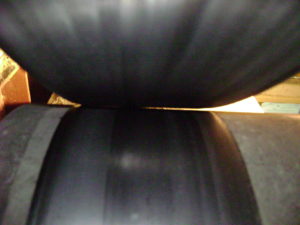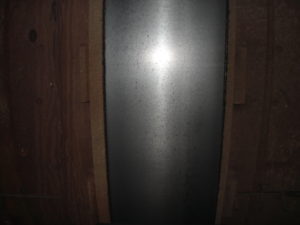Precision Two Phase Alignment
Rotary Service Company corrects the Alignment of Trunnion Mounted Rotary Vessels by conducting a precision two phase alignment
To“float” the vessel between its thrust rollers or stops
RSC personnel make necessary adjustments, skewing and shimming all the trunnions providing good face contact between the tires and trunnions. In addition, we adjust the vessel’s thrust or “float” for optimum performance. Vessel alignment is critical to good operations. A poorly aligned vessel creates premature wear to rotating components of the vessel.
Dimensional data is collected such as tire and trunnion circumferences, and slope of the trunnion bases. Alignment of the bases in relation to centerline of the vessel is verified, as well as other measurements provided our engineer who calculates the shimming and adjustment procedures required to properly align your vessel.
In some cases, we must repair bad contact surfaces between tires and trunnions on vessels utilizing Tire and Trunnion Grinding procedures prior to alignment. See our (Tire and Trunnion Grinding) page for more information.
PRECISION ALIGNMENT ACCOMPLISHED IN TWO PHASES
Cold Phase
The unit runs at ambient temperature and under minimal load conditions. Major adjustments made to the unit at this time. This phase requires the unit lifted off the trunnions adding or removing shims under the trunnions. Tire & Trunnion face profiles verified along with trunnion bases checked for proper elevation and alignment.
Hot Phase
The unit is at operational temperature and production load, RSC technicians check the unit, verify proper setup of the trunnions. The “float” validated and the face contact between the tires and trunnions checked for air gap. Minor corrections made to fine-tune the unit’s performance.

AIR GAP – TRUNNION MISALIGNED

GOOD WEAR PATTERN ACROSS THE FACE
OVALITY TESTING
FOR REFRACTORY LOSS
RSC also evaluates vessels seeing extreme heat such as kilns or other refractory lined vessels. Evaluation of ovality within the shell is required to properly identify issues causing the refractory loss. In addition to optical measuring devices, laser equipment and manual recording devices, RSC determines the actual center of the vessel. Additionally, degree of flex in the vessel is determined, and mapping the shell profile in several locations completed. Degree of slope verified, and alignment between trunnion bases in relation to the centerline of the vessel verified. Finally, our mechanical engineer (PE) who has overseen the testing, analyzes results and provides a detailed report.
Ovality testing identifies your refractory problems.
RSC guarantees its parts and field maintenance services with a one-year warranty.
Our mission is to make the success of each client’s repair our own.
